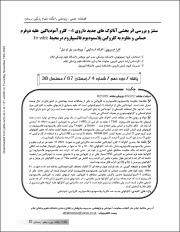| dc.contributor.author | Khosravi, afra | en_US |
| dc.contributor.author | Asadollahy, eghbaleh | en_US |
| dc.contributor.author | Oniel, poul | en_US |
| dc.date.accessioned | 1399-08-21T21:51:12Z | fa_IR |
| dc.date.accessioned | 2020-11-11T21:51:12Z | |
| dc.date.available | 1399-08-21T21:51:12Z | fa_IR |
| dc.date.available | 2020-11-11T21:51:12Z | |
| dc.date.issued | 2009-03-01 | en_US |
| dc.date.issued | 1387-12-11 | fa_IR |
| dc.identifier.citation | Khosravi, afra, Asadollahy, eghbaleh, Oniel, poul. (2009). Synthesis and study of effects of new 4-chloro – amodiaquine analogues against two resistant and sensitive forms to chloroquine Plasmodium Falciparum, in vitro. scientific magazine yafte, 10(4), 115-122. | en_US |
| dc.identifier.issn | 1563-0773 | |
| dc.identifier.uri | http://yafte.lums.ac.ir/article-1-111-en.html | |
| dc.identifier.uri | https://iranjournals.nlai.ir/handle/123456789/483847 | |
| dc.description.abstract | Background: Resistance to chloroquine (CQ) in Plasmodium falciparum malaria has become a major health concern of the developing countries.This resistance has prompted a re-examination of the pharmacology of alternative antimalarials that may be effective against resistant strains. Amodiaquine (AQ) is a 4-aminoquinoline antimalarial which is effective against many chloroquine-resistant strains of P. falciparum. However, clinical use of AQ has been severely restricted because of associations with hepatotoxicity and agranulocytosis. The aim of this study was to examine the effects of replacing the 4’OH function of amodiaquine with either chlorine or fluorine. Materials and Methods: A successful four-step synthesis of a new series of 4-chloro analogues has been designed and applied to the synthesis of an array of 10 analogues. Malaria parasites were maintained in continuous culture using the method of Jensen and Trager. Cultures were grown in flasks containing human erythrocytes (2-5%) with parasitemia in the range of 1% to 10% suspended in RPMI 1640 medium supplemented with 25 mM HEPES and 32 mM NaHCO3, and 10% human serum (complete medium). Cultures were gassed with a mixture of 3% O2, 6% CO2 and 91% N2 and were kept in a 30 degree temperature. Results: It is apparent that several analogues had very potent antimalarial activity against both strains of the parasite. In particular 5b, 5c and 5i were not only active in the single nanomolar range, but they also displayed little cross-resistance. Against the sensitive HB3 strain, these analogues were superior to chloroquine and slightly more potent than amodiaquine. Activity was reduced when the side-chain was large (eg. dibutyl analogue and pyridine analogues, 5g and 5j respectively). Discussion: In a four - step Process, 10 different chloro - amodiaquine were synthesized which showed (in vitro) Promising effects against chloroquine resistant strains of Plasmodium falciparum. It is clear that the 4’chloro series has several members with higher or equivalent activity to amodiaquine (and 4(b)). In particular, given the metabolic resilience of the N-tert butyl side-chain (as seen in metabolism studies with 4b) analogue 5b looks like an excellent candidate worthy of further investigation. | en_US |
| dc.format.extent | 189 | |
| dc.format.mimetype | application/pdf | |
| dc.language | English | |
| dc.language.iso | en_US | |
| dc.relation.ispartof | scientific magazine yafte | en_US |
| dc.relation.ispartof | مجله علمی پژوهشی یافته | fa_IR |
| dc.subject | Chloroquine | en_US |
| dc.subject | Amodiaquine | en_US |
| dc.subject | New analogues | en_US |
| dc.subject | Plasmodium falciparum | en_US |
| dc.subject | Antimalarial activity. | en_US |
| dc.title | Synthesis and study of effects of new 4-chloro – amodiaquine analogues against two resistant and sensitive forms to chloroquine Plasmodium Falciparum, in vitro | en_US |
| dc.type | Text | en_US |
| dc.type | Research | en_US |
| dc.citation.volume | 10 | |
| dc.citation.issue | 4 | |
| dc.citation.spage | 115 | |
| dc.citation.epage | 122 | |





